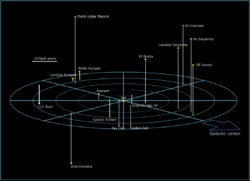Human colonies: Difference between revisions
From Halopedia, the Halo wiki
No edit summary |
|||
| Line 72: | Line 72: | ||
*[[Epsilon Indi system]] | *[[Epsilon Indi system]] | ||
**[[Harvest]] - Glassed in [[2525]], recaptured by UNSC in [[2531]] | **[[Harvest]] - Glassed in [[2525]], recaptured by UNSC in [[2531]] | ||
*Escala system | |||
**[[Escala III]] - Still held by the [[UNSC]]. | |||
*[[Groombridge 1830 system]] | *[[Groombridge 1830 system]] | ||
**[[Groombridge-1830]] - Unsuccessfully attacked by Covenant | **[[Groombridge-1830]] - Unsuccessfully attacked by Covenant | ||
Revision as of 10:14, March 26, 2014
Under the administration of the Unified Earth Government, humanity has surveyed and colonized a vast number of worlds across the Orion Arm of the Milky Way galaxy over 200 years of superluminal travel via Slipstream space, following nearly three centuries of expansion across the Sol system. The planets under the jurisdiction of the UEG, together with humanity's homeworld, are collectively referred to as "Earth and Her Colonies".[1] As of 2490, a total of 800 colonies had been established, many of them firmly under the influence of the UEG with some seeking to secede from humanity's empire.[2]
History
Prehistory
- Main article: Prehistoric human civilization
Over 110,000 years ago, humanity was an advanced, spacefaring race, and had colonized thousands of worlds across the Orion Arm of the galaxy. However, after being exhausted by the parasitic Flood and eventually suffering a disastrous defeat against the Forerunners in the human-Forerunner wars, the Forerunners forcibly regressed humanity to a Tier 7 species and all traces of this advanced civilization were erased.
Interplanetary age
- Main article: Early history of the UNSC
The concept of space colonization was born out of the need to expand human habitation outside of Earth to prevent overpopulation, to alleviate the consumption of Earth's resources by conducting planetary mining on other worlds, and to better understand the universe as human civilization expanded. Various approaches were suggested to achieve this, such as colonization efforts of the Moon and Mars, building facilities on orbiting asteroids and creating artificial platforms.
The first recorded success of human colonization in the modern age was made in the later half of the 21st century, more specifically in 2080. The Moon and Mars saw humanity's first expansion, followed by a number of asteroids and the natural satellites orbiting Jupiter. The rapid pace of interplanetary colonization was driven by commercial interests more than the efforts on the part of national governments: Earth bio- and nanotechnology corporations sought to conduct scientific research unhindered by Earth's international law as well as its gravity. Mars, in particular, quickly became an important hub of leading-edge science and industry, and would continue to be so for hundreds of years, particularly in the area of spaceship manufacturing. Advancements in terraforming technologies transformed many of the formerly inhospitable planets and moons of the Solar System into worlds capable of sustaining life.[3]
Despite these successes, the efforts did not solve Earth's overpopulation issue. It eventually led to political unrest, contributing to the formation of political movements promising independence from the national governments on Earth and the perceived oppression by the United Nations.[2] Operating across the colonized worlds and orbital platforms of the Sol system, the Frieden movement and the Koslovics were the most prominent of these rebel factions. Beginning with a Frieden attack on the United Nations colonial advisers in the Jovian Moons and the subsequent UN response, battles were fought over the colony worlds—as well as Earth itself—from 2160 to 2170, culminating in a UN victory in the Interplanetary War. The outcome of the space wars led to the establishment of the Unified Earth Government as a centralized governing body tasked to ensure Earth's influence over the colony worlds and a powerful, united military force known as the United Nations Space Command.[2]
Expansion beyond Sol system

The technological innovation of the Shaw-Fujikawa Translight Engine in 2291 sprung the human civilization into the space-faring age, allowing them to travel beyond Sol system. Half a century later, the UEG constructed its first line of colony ships - led by Odyssey - to initiate the expansion of human habitation, relieving the growing pressure of overpopulation on Earth and the off-world colonies across the Sol system.[2] To manage governance in the extrasolar colonies as well as to ensure their security, the UEG established the Colonial Administration Authority and the Colonial Military Administration in 2310.[4] Two centuries later, both bodies would be marginalized—the latter due to widespread insurgent sympathies in its ranks—and eventually absorbed into the UNSC's emergency military government in 2525.[5]
Golden Age
- Main articles: Inner Colonies, Outer Colonies
As faster-than-light travel was still new and highly expensive, potential colonists were subjected to rigorous physical and mental testing to determine their suitability for the extrasolar colonization programs. As such, the colonists who formed the basis for the 210 first-wave colonies settled before 2390 formed humanity's elite; these worlds would later be known as the Inner Colonies. Earth and the Inner Colonies soon became the political and economic basis of the UNSC as humanity began expanding to the Outer Colonies.[2] For humanity at large, this was a time of unparalleled prosperity and optimism which has later come to be referred to as the "Golden Age" of human colonization,[6] a period which would eventually come to a violent end in the later years of the 25th century.[7]
By the time the settlement of the Outer Colonies began, many of the initial difficulties of interstellar travel had been alleviated; by extension, the selection criteria for the colonists became far more lax, resulting in the populace of the Outer Colonies being far more varied than that of the prestigious Inner Colonies.[7]
Colonial expansion continued and by 2490, UEG colonial space encompassed over 800 worlds in the Orion Arm. The success of colonization of the Outer Colonies made the Inner Colonies the primary stronghold, both military and economic, though they relied heavily on raw materials supplied by the Outer Colonies. During this period, the planet Reach (orbiting Epsilon Eridani, right on Earth's metaphorical doorstep) became the UNSC's primary naval yard and training academy. Reach was a major producer of warships and colony vessels, as well as a training ground for covert operatives and Special Forces.
At its peak, human-controlled space encompassed hundreds of star systems and planets, moons and planetoids settled by colonists, some terraformed to greater degrees than others depending on the local conditions and presence of indigenous life. The colonies ranged from heavily-populated and economically, politically and strategically significant worlds to struggling pioneer outposts which could barely sustain 10,000 colonists.[8] The Inner Colonies encompassed a region of space in at least a 10.5 light-year three-dimensional radius from Earth. Beyond that were the Outer Colonies. Other colonies were established even further - Coral, at 42 light-years;[9] and Madrigal, which lay in the 23 Librae system, 83.7 light-years from Earth.[10] In 2456, Harvest was the furthest Outer Colony, at six weeks of Slipspace travel away from Madrigal and two months from Reach.[11]
Insurrection
- Main article: Insurrection
While the Unified Earth Government was technically a confederation of equal, independently-governed worlds, this was not true in practice;[8] the interests of Earth and the Inner Colonies weighed far more heavily in the government's decision-making than those of the Outer Colonies.[12] The Inner Colonies' reliance on the Outer Colonies prompted the Unified Earth Government to maintain its hold over the Outer Colonies, but it inevitably began to lose its ability to do so as the Outer Colonies eventually surrounded the core worlds and far surpassed them in number. The overbearing influence of the Earth government, enforced by the UNSC and, initially, the Colonial Military Administration, led to a growing secessionist sentiment among Outer Colony citizens. The more radical elements of this movement took up arms against the UNSC, sparking a series of brushfire wars—collectively known as the Insurrection—in the late 2490's.[7]
The Covenant War
- Main article: Human-Covenant War
On April 20, 2525, contact with the Outer Colony, Harvest, was lost. After failing to re-establish contact with Harvest, the Colonial Military Administration sent a scout ship, the Argo, to investigate. Contact with the Argo was subsequently lost after the ship arrived in the Harvest system, plunging humanity into a deadly war with an alien hegemony known as the Covenant. Harvest was bombarded from orbit in a process which would come to be known as glassing, marking the beginning of a 28-year war with the Covenant. During the war, hundreds of human colonies were destroyed and billions of human civilians and military personnel were killed by the Covenant. Following the conclusion of the war, an extensive reconstruction process began in order to rebuild humanity's shattered colonial empire. By 2589, glassed colonies like Reach had been re-terraformed to some degree and open for re-settlement.[13]
List of known colonies
Inner Colonies
Outer Colonies
|
Other/unspecified
|
Notes
- ^ The presence of orbital defense platforms around New Carthage implies that it is an Inner Colony, though this has not been confirmed.
Sources
- ^ Halo 3 level, Halo (Eulogy)
- ^ a b c d e Xbox.com/Halo - Timeline
- ^ Halo Encyclopedia, page 42 (2011)
- ^ Halo 4: The Essential Visual Guide, page 228
- ^ Halo Story Page: Frank O'Connor/Robt McLees Interview - August 2008
- ^ Halo: Evolutions, "The Impossible Life and the Possible Death of Preston J. Cole", pages 415-416
- ^ a b c Halo: Evolutions, "The Impossible Life and the Possible Death of Preston J. Cole", page 428-429
- ^ a b Halo Encyclopedia, page 43 (2011)
- ^ I Love Bees
- ^ Halo: The Cole Protocol
- ^ Halo: Contact Harvest
- ^ YouTube: Halo: From A to Z with Frank O'Connor
- ^ Halo: Reach, campaign level Lone Wolf
